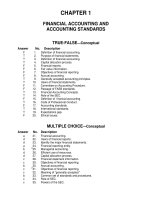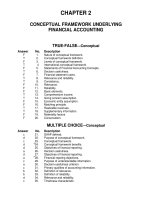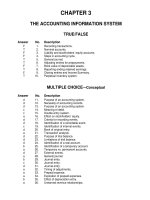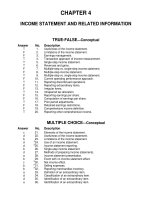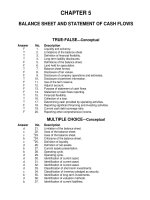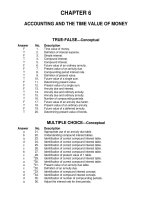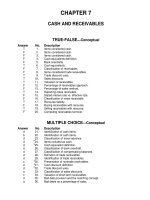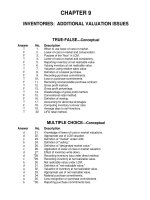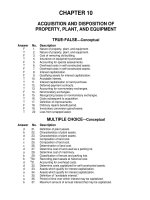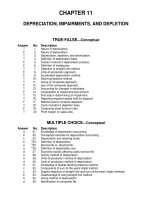Test bank with answers intermediate accounting 12e by kieso chapter 18
Bạn đang xem bản rút gọn của tài liệu. Xem và tải ngay bản đầy đủ của tài liệu tại đây (139.85 KB, 42 trang )
To download more slides, ebook, solutions and test bank, visit
CHAPTER 18
REVENUE RECOGNITION
TRUE-FALSE—Conceptual
Answer
F
T
T
F
T
F
T
T
F
F
T
F
F
T
F
F
T
T
F
T
No.
Description
1.
2.
3.
4.
5.
6.
7.
8.
9.
10.
11.
12.
13.
14.
15.
16.
17.
18.
19.
20.
Recognition of revenue.
Realization of revenue.
Delayed recognition of revenue.
Recognizing revenue when right of return exists.
Recognizing revenue prior to product completion.
Use of percentage-of-completion method.
Input measure for contract progress.
Reporting Construction in Process and Billings on Construction in Process.
Construction in Process account balance.
Recognition of revenue under completed-contract method.
Principal advantage of completed-contract method.
Recognizing loss on an unprofitable contract.
Recognizing current period loss on a profitable contract.
Recognizing revenue under completion-of-production basis.
Recording a loss on an unprofitable contract.
Deferring revenue under installment-sales method.
Deferring gross profit under installment-sales method.
Classification of deferred gross profit.
Recognizing revenue under cost-recovery method.
Recognizing profit under cost-recovery method.
MULTIPLE CHOICE—Conceptual
Answer
c
b
a
b
d
b
d
d
c
d
b
c
b
c
b
a
b
d
No.
21.
22.
23.
S
24.
P
25.
P
26.
27.
28.
29.
30.
31.
32.
33.
34.
35.
36.
37.
S
38.
Description
Revenue recognition principle.
Definition of "realized."
Definition of "earned."
Revenue recognition representations.
Definition of recognition.
Revenue recognition principle.
Recognizing revenue at point of sale.
Recording sales when right of return exists.
Revenue recognition when right of return exists.
Revenue recognition when right of return exists.
Appropriate accounting method for long-term contracts.
Percentage-of-completion method.
Percentage-of-completion method.
Classification of progress billings and construction in process.
Calculation of gross profit using percentage-of-completion.
Disclosure of earned but unbilled revenues.
Disadvantage of using percentage-of-completion.
Percentage-of-completion input measures.
To download more slides, ebook, solutions and test bank, visit
18 - 2
Test Bank for Intermediate Accounting, Twelfth Edition
MULTIPLE CHOICE—Conceptual (cont.)
Answer
a
c
a
c
d
a
d
b
c
c
b
b
c
d
b
b
d
d
a
b
a
d
No.
S
39.
40.
41.
42.
43.
44.
S
45.
S
46.
47.
48.
49.
50.
S
51.
P
52.
53.
54.
55.
*56.
*57
*58.
*59.
*60.
Description
Advantage of completed-contract method
Revenue, cost, and gross profit under the completed-contract method.
Loss recognition on a long-term contract.
Accounting for long-term contract losses.
Criteria for revenue recognition of completion of production.
Completion-of-production basis.
Revenue recognition of completion of production.
Treatment of estimated contract cost increase.
Presentation of deferred gross profit.
Appropriate use of the installment-sales method.
Valuing repossessed assets.
Gross profit deferred under the installment-sales method.
Income realization on installment sales.
Conservative revenue recognition method.
Income recognition under the cost-recovery method.
Income recognition under the cost-recovery method.
Cost recovery basis of revenue recognition.
Allocation of initial franchise fee.
Recognition of continuing franchise fees.
Future bargain purchase option.
Option to purchase franchisee's business agreement.
Revenue recognition by the consignor.
P
These questions also appear in the Problem-Solving Survival Guide.
These questions also appear in the Study Guide.
*This topic is dealt with in an Appendix to the chapter.
S
MULTIPLE CHOICE—Computational
Answer
c
c
b
d
c
b
c
a
b
a
c
b
c
a
b
c
c
a
No.
Description
61.
62.
63.
64.
65.
66.
67.
68.
69.
70.
71.
72.
73.
74.
75.
76.
77.
78.
Percentage-of-completion method.
Percentage-of-completion method.
Determine cash collected on long-term construction contract.
Determine gross profit using percentage-of-completion.
Gross profit to be recognized using percentage-of-completion.
Gross profit to be recognized using percentage-of-completion.
Profit to be recognized using completed-contract method.
Gross profit to be recognized using percentage-of-completion.
Profit to be recognized using completed-contract method.
Gross profit to be recognized using percentage-of-completion.
Gross profit to be recognized using completed-contract method.
Computation of construction costs incurred.
Gross profit recognized under percentage-of-completion.
Computation of construction in process amount.
Loss recognized using completed-contract method.
Revenue recognition using completed-contract method.
Reporting a current liability with completed-contract-method.
Reporting inventory under completed-contract method.
To download more slides, ebook, solutions and test bank, visit
Revenue Recognition
MULTIPLE CHOICE—Computational (cont.)
Answer
d
b
a
b
b
b
d
d
a
d
a
d
c
b
d
a
No.
79.
80.
81.
82.
83.
84.
85.
86.
87.
88.
89.
*90.
*91.
*92.
*93.
*94.
Description
Gain recognized on repossession—installment sale.
Calculate loss on repossessed merchandise.
Calculate loss on repossessed merchandise.
Interest recognized on installment sales.
Calculation of deferred gross profit amount.
Computation of realized gross profit amount.
Computation of loss on repossession.
Calculation of gross profit rate.
Computation of net income from installment sales.
Computation of realized and deferred gross profit.
Revenue recognized under the cost-recovery method.
Cancellation of franchise agreement.
Accounting for initial and annual continuing franchise fees.
Franchise fee with a bargain purchase option.
Sales on consignment.
Reporting inventory on consignment.
MULTIPLE CHOICE—CPA Adapted
Answer
a
b
d
d
c
b
c
c
c
c
a
No.
95.
96.
97.
98.
99.
100.
101.
102.
103.
104.
105.
Description
FASB's definition of "recognition."
Determine contract costs incurred during year.
Gross profit to be recognized using percentage-of-completion.
Profit to be recognized using completed-contract method.
Revenue recognized under completed-production method.
Determine balance of installment accounts receivable.
Calculate deferred gross profit—installment sales.
Calculate deferred gross profit—installment sales.
Balance of deferred gross profit—installment sales.
Reporting deferred gross profit—installment sales.
Effect of collections received on service contracts.
EXERCISES
Item
E18-106
E18-107
E18-108
E18-109
E18-110
E18-111
E18-112
E18-113
E18-114
E18-115
*E18-116
Description
Revenue recognition (essay).
Revenue recognition (essay).
Long-term contracts (essay).
Journal entries—percentage-of-completion.
Percentage-of-completion method.
Percentage-of-completion method.
Percentage-of-completion and completed-contract methods.
Installment sales.
Installment sales.
Installment sales.
Franchises.
18 - 3
To download more slides, ebook, solutions and test bank, visit
Test Bank for Intermediate Accounting, Twelfth Edition
18 - 4
PROBLEMS
Item
P18-117
P18-118
P18-119
P18-120
Description
Long-term construction project accounting.
Accounting for long-term construction contracts.
Long-term contract accounting—completed-contract.
Installment sales.
CHAPTER LEARNING OBJECTIVES
1.
Apply the revenue recognition principle.
2.
Describe accounting issues for revenue recognition at point of sale.
3.
Apply the percentage-of-completion method for long-term contracts.
4.
Apply the completed-contract method for long-term contracts.
5.
Identify the proper accounting for losses on long-term contracts.
6.
Describe the installment-sales method of accounting.
7.
Explain the cost-recovery method of accounting.
*8.
Explain revenue recognition for franchises and consignment sales.
To download more slides, ebook, solutions and test bank, visit
Revenue Recognition
18 - 5
SUMMARY OF LEARNING OBJECTIVES BY QUESTIONS
Item
Type
Item
Type
Item
1.
2.
TF
TF
3.
21.
TF
MC
22.
23.
4.
5.
TF
TF
6.
27.
TF
MC
28.
29.
7.
8.
9.
31.
32.
TF
TF
TF
MC
MC
33.
34.
35.
36.
37.
MC
MC
MC
MC
MC
10.
11.
S
39.
TF
TF
MC
40.
67.
69.
MC
MC
MC
71.
75.
76.
12.
13.
TF
TF
14.
15.
TF
TF
41.
42.
16.
17.
18.
47.
TF
TF
TF
MC
48.
49.
50.
S
51.
MC
MC
MC
MC
79.
80.
81.
82.
19.
TF
20.
TF
56.
57.
MC
MC
58.
59.
MC
MC
Note: TF = True-False
MC = Multiple Choice
E = Exercise
P = Problem
S
38.
61.
62.
63.
64.
P
52.
60.
90.
Type
Item
Type
Item
Learning Objective 1
S
P
MC
24. MC
26.
P
MC
25. MC
95.
Learning Objective 2
MC
30. MC
MC
107.
E
Learning Objective 3
MC
65. MC
73.
MC
66. MC
74.
MC
68. MC
96.
MC
70. MC
97.
MC
72. MC
108.
Learning Objective 4
MC
77. MC
108.
MC
78. MC
112.
MC
98. MC
118.
Learning Objective 5
S
MC
43. MC
45.
S
MC
44. MC
46.
Learning Objective 6
MC
83. MC
87.
MC
84. MC
88.
MC
85. MC
100.
MC
86. MC
101.
Learning Objective 7
MC
53. MC
54.
Learning Objective 8*
MC
91. MC
93.
MC
92. MC
94.
Type
Item
Type
Item
Type
MC
MC
106.
107.
E
E
MC
MC
MC
MC
E
109.
110.
111.
112.
117.
E
E
E
E
P
118.
P
E
E
P
119.
P
MC
MC
99.
117.
MC
P
118.
P
MC
MC
MC
MC
102.
103.
104.
105.
MC
MC
MC
MC
113.
114.
115.
120.
E
E
E
P
MC
55.
MC
89.
MC
MC
MC
116.
E
To download more slides, ebook, solutions and test bank, visit
18 - 6
Test Bank for Intermediate Accounting, Twelfth Edition
TRUE-FALSE—Conceptual
1.
Companies should recognize revenue when it is realized and when cash is received.
2.
Revenues are realized when a company exchanges goods and services for cash or
claims to cash.
3.
Delayed recognition of revenue is appropriate if the sale does not represent substantial
completion of the earnings process.
4.
If a company sells its product but gives the buyer the right to return it, the company should
not recognize revenue until the sale is collected.
5.
Companies can recognize revenue prior to completion and delivery of the product under
certain circumstances.
6.
Companies must use the percentage-of-completion method when estimates of progress
toward completion are reasonably dependable.
7.
The most popular input measure used to determine the progress toward completion is the
cost-to-cost basis.
8.
If the difference between the Construction in Process and the Billings on Construction in
Process account balances is a debit, the difference is reported as a current asset.
9.
The Construction in Process account includes only construction costs under the
percentage-of-completion method.
10.
Under the completed-contract method, companies recognize revenue and costs only
when the contract is completed.
11.
The principal advantage of the completed-contract method is that reported revenue
reflects final results rather than estimates.
12.
Companies must recognize a loss on an unprofitable contract under the percentage-ofcompletion method but not the completed-contract method.
13.
A loss in the current period on a profitable contract must be recognized under both the
percentage-of-completion and completed-contract method.
14.
Under the completion-of-production basis, companies recognize revenue when agricultural crops are harvested since the sales price is reasonably assured and no significant
costs are involved in product distribution.
15.
The provision for a loss on an unprofitable contract may be combined with the
Construction in Process account balance under percentage-of-completion but not
completed-contract.
16.
Under the installment-sales method, companies defer revenue and income recognition
until the period of cash collection.
To download more slides, ebook, solutions and test bank, visit
Revenue Recognition
18 - 7
17.
The installment-sales method defers only the gross profit instead of both the sales price
and cost of goods sold.
18.
Deferred gross profit is generally treated as an unearned revenue and classified as a
current liability.
19.
Under the cost-recovery method, a company recognizes no revenue or profit until cash
payments by the buyer exceed the cost of the merchandise sold.
20.
Companies recognize profit under the cost-recovery method only when cash collections
exceed the total cost of the goods sold.
True-False Answers—Conceptual
Item
1.
2.
3.
4.
5.
Ans.
F
T
T
F
T
Item
6.
7.
8.
9.
10.
Ans.
F
T
T
F
F
Item
11.
12.
13.
14.
15.
Ans.
T
F
F
T
F
Item
16.
17.
18.
19.
20.
Ans.
F
T
T
F
T
MULTIPLE CHOICE—Conceptual
21.
The revenue recognition principle provides that revenue is recognized when
a. it is realized.
b. it is realizable.
c. it is realized or realizable and it is earned.
d. none of these.
22.
When goods or services are exchanged for cash or claims to cash (receivables), revenues
are
a. earned.
b. realized.
c. recognized.
d. all of these.
23.
When the entity has substantially accomplished what it must do to be entitled to the
benefits represented by the revenues, revenues are
a. earned.
b. realized.
c. recognized.
d. all of these.
To download more slides, ebook, solutions and test bank, visit
18 - 8
Test Bank for Intermediate Accounting, Twelfth Edition
S
Which of the following is not an accurate representation concerning revenue recognition?
a. Revenue from selling products is recognized at the date of sale, usually interpreted to
mean the date of delivery to customers.
b. Revenue from services rendered is recognized when cash is received or when
services have been performed.
c. Revenue from permitting others to use enterprise assets is recognized as time passes
or as the assets are used.
d. Revenue from disposing of assets other than products is recognized at the date of
sale.
P
The process of formally recording or incorporating an item in the financial statements of
an entity is
a. allocation.
b. articulation.
c. realization.
d. recognition.
P
26.
Dot Point, Inc. is a retailer of washers and dryers and offers a three-year service contract
on each appliance sold. Although Dot Point sells the appliances on an installment basis,
all service contracts are cash sales at the time of purchase by the buyer. Collections
received for service contracts should be recorded as
a. service revenue.
b. deferred service revenue.
c. a reduction in installment accounts receivable.
d. a direct addition to retained earnings.
27.
Which of the following is not a reason why revenue is recognized at time of sale?
a. Realization has occurred.
b. The sale is the critical event.
c. Title legally passes from seller to buyer.
d. All of these are reasons to recognize revenue at time of sale.
28.
An alternative available when the seller is exposed to continued risks of ownership
through return of the product is
a. recording the sale, and accounting for returns as they occur in future periods.
b. not recording a sale until all return privileges have expired.
c. recording the sale, but reducing sales by an estimate of future returns.
d. all of these.
29.
A sale should not be recognized as revenue by the seller at the time of sale if
a. payment was made by check.
b. the selling price is less than the normal selling price.
c. the buyer has a right to return the product and the amount of future returns cannot be
reasonably estimated.
d. none of these.
30.
The FASB concluded that if a company sells its product but gives the buyer the right to
return the product, revenue from the sales transaction shall be recognized at the time of
sale only if all of six conditions have been met. Which of the following is not one of these
six conditions?
24.
25.
To download more slides, ebook, solutions and test bank, visit
Revenue Recognition
18 - 9
a. The amount of future returns can be reasonably estimated.
b. The seller's price is substantially fixed or determinable at time of sale.
c. The buyer's obligation to the seller would not be changed in the event of theft or
damage of the product.
d. The buyer is obligated to pay the seller upon resale of the product.
31.
In selecting an accounting method for a newly contracted long-term construction project,
the principal factor to be considered should be
a. the terms of payment in the contract.
b. the degree to which a reliable estimate of the costs to complete and extent of progress
toward completion is practicable.
c. the method commonly used by the contractor to account for other long-term construction contracts.
d. the inherent nature of the contractor's technical facilities used in construction.
32.
The percentage-of-completion method must be used when certain conditions exist. Which
of the following is not one of those necessary conditions?
a. Estimates of progress toward completion, revenues, and costs are reasonably
dependable.
b. The contractor can be expected to perform the contractual obligation.
c. The buyer can be expected to satisfy some of the obligations under the contract.
d. The contract clearly specifies the enforceable rights of the parties, the consideration to
be exchanged, and the manner and terms of settlement.
33.
When work to be done and costs to be incurred on a long-term contract can be estimated
dependably, which of the following methods of revenue recognition is preferable?
a. Installment-sales method
b. Percentage-of-completion method
c. Completed-contract method
d. None of these
34.
How should the balances of progress billings and construction in process be shown at
reporting dates prior to the completion of a long-term contract?
a. Progress billings as deferred income, construction in progress as a deferred expense.
b. Progress billings as income, construction in process as inventory.
c. Net, as a current asset if debit balance, and current liability if credit balance.
d. Net, as income from construction if credit balance, and loss from construction if debit
balance.
35.
In accounting for a long-term construction-type contract using the percentage-ofcompletion method, the gross profit recognized during the first year would be the
estimated total gross profit from the contract, multiplied by the percentage of the costs
incurred during the year to the
a. total costs incurred to date.
b. total estimated cost.
c. unbilled portion of the contract price.
d. total contract price.
36.
How should earned but unbilled revenues at the balance sheet date on a long-term
construction contract be disclosed if the percentage-of-completion method of revenue
recognition is used?
To download more slides, ebook, solutions and test bank, visit
18 - 10 Test Bank for Intermediate Accounting, Twelfth Edition
a.
b.
c.
d.
37.
As construction in process in the current asset section of the balance sheet.
As construction in process in the noncurrent asset section of the balance sheet.
As a receivable in the noncurrent asset section of the balance sheet.
In a note to the financial statements until the customer is formally billed for the portion
of work completed.
The principal disadvantage of using the percentage-of-completion method of recognizing
revenue from long-term contracts is that it
a. is unacceptable for income tax purposes.
b. gives results based upon estimates which may be subject to considerable uncertainty.
c. is likely to assign a small amount of revenue to a period during which much revenue
was actually earned.
d. none of these.
S
One of the more popular input measures used to determine the progress toward
completion in the percentage-of-completion method is
a. revenue-percentage basis.
b. cost-percentage basis.
c. progress completion basis.
d. cost-to-cost basis.
S
39.
The principal advantage of the completed-contract method is that
a. reported revenue is based on final results rather than estimates of unperformed work.
b. it reflects current performance when the period of a contract extends into more than
one accounting period.
c. it is not necessary to recognize revenue at the point of sale.
d. a greater amount of gross profit and net income is reported than is the case when the
percentage-of-completion method is used.
40.
Under the completed-contract method
a. revenue, cost, and gross profit are recognized during the production cycle.
b. revenue and cost are recognized during the production cycle, but gross profit
recognition is deferred until the contract is completed.
c. revenue, cost, and gross profit are recognized at the time the contract is completed.
d. none of these.
41.
Cost estimates on a long-term contract may indicate that a loss will result on completion of
the entire contract. In this case, the entire expected loss should be
a. recognized in the current period, regardless of whether the percentage-of-completion
or completed-contract method is employed.
b. recognized in the current period under the percentage-of-completion method, but the
completed-contract method should defer recognition of the loss to the time when the
contract is completed.
c. recognized in the current period under the completed-contract method, but the
percentage-of-completion method should defer the loss until the contract is completed.
d. deferred and recognized when the contract is completed, regardless of whether the
percentage-of-completion or completed-contract method is employed.
38.
To download more slides, ebook, solutions and test bank, visit
Revenue Recognition
18 - 11
42.
Cost estimates at the end of the second year indicate a loss will result on completion of
the entire contract. Which of the following statements is correct?
a. Under the completed-contract method, the loss is not recognized until the year the
construction is completed.
b. Under the percentage-of-completion method, the gross profit recognized in the first
year must not be changed.
c. Under the completed-contract method, when the billings exceed the accumulated
costs, the amount of the estimated loss is reported as a current liability.
d. Under the completed-contract method, when the Construction in Process balance
exceeds the billings, the estimated loss is added to the accumulated costs.
43.
The criteria for recognition of revenue at the completion of production of precious metals
and farm products include
a. an established market with quoted prices.
b. low additional costs of completion and selling.
c. units are interchangeable.
d. all of these.
44.
In certain cases, revenue is recognized at the completion of production even though no
sale has been made. Which of the following statements is not true?
a. Examples involve precious metals or farm equipment.
b. The products possess immediate marketability at quoted prices.
c. No significant costs are involved in selling the product.
d. All of these statements are true.
S
For which of the following products is it appropriate to recognize revenue at the
completion of production even though no sale has been made?
a. Automobiles
b. Large appliances
c. Single family residential units
d. Precious metals
S
46.
When there is a significant increase in the estimated total contract costs but the increase
does not eliminate all profit on the contract, which of the following is correct?
a. Under both the percentage-of-completion and the completed-contract methods, the
estimated cost increase requires a current period adjustment of excess gross profit
recognized on the project in prior periods.
b. Under the percentage-of-completion method only, the estimated cost increase
requires a current period adjustment of excess gross profit recognized on the project
in prior periods.
c. Under the completed-contract method only, the estimated cost increase requires a
current period adjustment of excess gross profit recognized on the project in prior
periods.
d. No current period adjustment is required.
47.
Deferred gross profit on installment sales is generally treated as a(n)
a. deduction from installment accounts receivable.
b. deduction from installment sales.
c. unearned revenue and classified as a current liability.
d. deduction from gross profit on sales.
45.
To download more slides, ebook, solutions and test bank, visit
18 - 12 Test Bank for Intermediate Accounting, Twelfth Edition
48.
The installment-sales method of recognizing profit for accounting purposes is acceptable if
a. collections in the year of sale do not exceed 30% of the total sales price.
b. an unrealized profit account is credited.
c. collection of the sales price is not reasonably assured.
d. the method is consistently used for all sales of similar merchandise.
49.
The method most commonly used to report defaults and repossessions is
a. provide no basis for the repossessed asset thereby recognizing a loss.
b. record the repossessed merchandise at fair value, recording a gain or loss if appropriate.
c. record the repossessed merchandise at book value, recording no gain or loss.
d. none of these.
50.
Under the installment-sales method,
a. revenue, costs, and gross profit are recognized proportionate to the cash that is
received from the sale of the product.
b. gross profit is deferred proportionate to cash uncollected from sale of the product, but
total revenues and costs are recognized at the point of sale.
c. gross profit is not recognized until the amount of cash received exceeds the cost of
the item sold.
d. revenues and costs are recognized proportionate to the cash received from the sale of
the product, but gross profit is deferred until all cash is received.
S
The realization of income on installment sales transactions involves
a. recognition of the difference between the cash collected on installment sales and the
cash expenses incurred.
b. deferring the net income related to installment sales and recognizing the income as
cash is collected.
c. deferring gross profit while recognizing operating or financial expenses in the period
incurred.
d. deferring gross profit and all additional expenses related to installment sales until cash
is ultimately collected.
P
52.
A manufacturer of large equipment sells on an installment basis to customers with
questionable credit ratings. Which of the following methods of revenue recognition is least
likely to overstate the amount of gross profit reported?
a. At the time of completion of the equipment (completion of production method)
b. At the date of delivery (sales method)
c. The installment-sales method
d. The cost–recovery method
53.
A seller is properly using the cost-recovery method for a sale. Interest will be earned on
the future payments. Which of the following statements is not correct?
a. After all costs have been recovered, any additional cash collections are included in
income.
b. Interest revenue may be recognized before all costs have been recovered.
c. The deferred gross profit is offset against the related receivable on the balance sheet.
d. Subsequent income statements report the gross profit as a separate item of revenue
when it is recognized as earned.
51.
To download more slides, ebook, solutions and test bank, visit
Revenue Recognition
18 - 13
54.
Under the cost-recovery method of revenue recognition,
a. income is recognized on a proportionate basis as the cash is received on the sale of
the product.
b. income is recognized when the cash received from the sale of the product is greater
than the cost of the product.
c. income is recognized immediately.
d. none of these.
55.
Winser, Inc. is engaged in extensive exploration for water in Utah. If, upon discovery of
water, Winser does not recognize any revenue from water sales until the sales exceed the
costs of exploration, the basis of revenue recognition being employed is the
a. production basis.
b. cash (or collection) basis.
c. sales (or accrual) basis.
d. cost recovery basis.
*56.
Some of the initial franchise fee may be allocated to
a. continuing franchise fees.
b. interest revenue on the future installments.
c. options to purchase the franchisee's business.
d. All of these may reduce the amount of the initial franchise fee that is recognized as
revenue.
*57.
Continuing franchise fees should be recorded by the franchisor
a. as revenue when earned and receivable from the franchisee.
b. as revenue when received.
c. in accordance with the accounting procedures specified in the franchise agreement.
d. as revenue only after the balance of the initial franchise fee has been collected.
*58.
Occasionally a franchise agreement grants the franchisee the right to make future bargain
purchases of equipment or supplies. When recording the initial franchise fee, the
franchisor should
a. increase revenue recognized from the initial franchise fee by the amount of the
expected future purchases.
b. record a portion of the initial franchise fee as unearned revenue which will increase
the selling price when the franchisee subsequently makes the bargain purchases.
c. defer recognition of any revenue from the initial franchise fee until the bargain
purchases are made.
d. None of these.
*59.
A franchise agreement grants the franchisor an option to purchase the franchisee's
business. It is probable that the option will be exercised. When recording the initial
franchise fee, the franchisor should
a. record the entire initial franchise fee as a deferred credit which will reduce the
franchisor's investment in the purchased outlet when the option is exercised.
b. record the entire initial franchise fee as unearned revenue which will reduce the
amount of cash paid when the option is exercised.
c. record the portion of the initial franchise fee which is attributable to the bargain
purchase option as a reduction of the future amounts receivable from the franchisee.
d. None of these.
To download more slides, ebook, solutions and test bank, visit
18 - 14 Test Bank for Intermediate Accounting, Twelfth Edition
*60.
Revenue is recognized by the consignor when the
a. goods are shipped to the consignee.
b. consignee receives the goods.
c. consignor receives an advance from the consignee.
d. consignor receives an account sales from the consignee.
Multiple Choice Answers—Conceptual
Item
21.
22.
23.
24.
25.
26.
Ans.
c
b
a
b
d
b
Item
27.
28.
29.
30.
31.
32.
Ans.
d
d
c
d
b
c
Item
33.
34.
35.
36.
37.
38.
Ans.
b
c
b
a
b
d
Item
39.
40.
41.
42.
43.
44.
Ans.
a
c
a
c
d
a
Item
45.
46.
47.
48.
49.
50.
Ans.
Item
Ans.
Item
Ans.
d
b
c
c
b
b
51.
52.
53.
54.
55.
*56.
c
d
b
b
d
d
*57.
*58.
*59.
*60.
a
b
a
d
MULTIPLE CHOICE—Computational
61.
Reese Construction Corporation contracted to construct a building for $1,500,000.
Construction began in 2007 and was completed in 2008. Data relating to the contract are
summarized below:
Year ended
December 31,
2007
2008
Costs incurred
$600,000
$450,000
Estimated costs to complete
400,000
—
Reese uses the percentage-of-completion method as the basis for income recognition.
For the years ended December 31, 2007, and 2008, respectively, Reese should report
gross profit of
a. $270,000 and $180,000.
b. $900,000 and $600,000.
c. $300,000 and $150,000.
d. $0 and $450,000.
62.
Winsor Construction Company uses the percentage-of-completion method of accounting.
In 2007, Winsor began work on a contract it had received which provided for a contract
price of $15,000,000. Other details follow:
2007
Costs incurred during the year
$7,200,000
Estimated costs to complete as of December 31
4,800,000
Billings during the year
6,600,000
Collections during the year
3,900,000
What should be the gross profit recognized in 2007?
a. $600,000
b. $7,800,000
c. $1,800,000
d. $3,000,000
To download more slides, ebook, solutions and test bank, visit
Revenue Recognition
18 - 15
Use the following information for questions 63 and 64.
In 2007, Crane Corporation began construction work under a three-year contract. The contract
price is $2,400,000. Crane uses the percentage-of-completion method for financial accounting
purposes. The income to be recognized each year is based on the proportion of costs incurred to
total estimated costs for completing the contract. The financial statement presentations relating to
this contract at December 31, 2007, follow:
Balance Sheet
Accounts receivable—construction contract billings
Construction in progress
Less contract billings
Costs and recognized profit in excess of billings
$100,000
$300,000
240,000
Income Statement
Income (before tax) on the contract recognized in 2007
60,000
$60,000
63.
How much cash was collected in 2007 on this contract?
a. $100,000
b. $140,000
c. $20,000
d. $240,000
64.
What was the initial estimated total income before tax on this contract?
a. $300,000
b. $320,000
c. $400,000
d. $480,000
65.
Eaton Construction Co. uses the percentage-of-completion method. In 2007, Eaton began
work on a contract for $3,300,000 and it was completed in 2008. Data on the costs are:
Year Ended December 31
2007
2008
Costs incurred
$1,170,000
$840,000
Estimated costs to complete
780,000
—
For the years 2007 and 2008, Eaton should recognize gross profit of
a.
b.
c.
d.
2007
$0
$774,000
$810,000
$810,000
2008
$1,290,000
$516,000
$480,000
$1,290,000
Use the following information for questions 66 and 67.
Ramos, Inc. began work in 2007 on contract #3814, which provided for a contract price of
$7,200,000. Other details follow:
2007
2008
Costs incurred during the year
$1,200,000
$3,675,000
Estimated costs to complete, as of December 31
3,600,000
0
Billings during the year
1,350,000
5,400,000
Collections during the year
900,000
5,850,000
To download more slides, ebook, solutions and test bank, visit
18 - 16 Test Bank for Intermediate Accounting, Twelfth Edition
66.
Assume that Ramos uses the percentage-of-completion method of accounting. The
portion of the total gross profit to be recognized as income in 2007 is
a. $450,000.
b. $600,000.
c. $1,800,000.
d. $2,400,000.
67.
Assume that Ramos uses the completed-contract method of accounting. The portion of
the total gross profit to be recognized as income in 2008 is
a. $900,000.
b. $1,350,000.
c. $2,325,000.
d. $7,200,000.
Use the following information for questions 68 and 69.
Miley, Inc. began work in 2007 on a contract for $8,400,000. Other data are as follows:
2007
2008
Costs incurred to date
$3,600,000
$5,600,000
Estimated costs to complete
2,400,000
—
Billings to date
2,800,000
8,400,000
Collections to date
2,000,000
7,200,000
68.
If Miley uses the percentage-of-completion method, the gross profit to be recognized in
2007 is
a. $1,440,000.
b. $1,600,000.
c. $2,160,000.
d. $2,400,000.
69.
If Miley uses the completed-contract method, the gross profit to be recognized in 2008 is
a. $1,360,000.
b. $2,800,000.
c. $1,400,000.
d. $5,600,000.
Use the following information for questions 70 and 71.
70.
Parker Construction Co. uses the percentage-of-completion method. In 2007, Parker
began work on a contract for $5,500,000; it was completed in 2008. The following cost
data pertain to this contract:
Year Ended December 31
2007
2008
Cost incurred during the year
$1,950,000
$1,400,000
Estimated costs to complete at the end of year
1,300,000
—
The amount of gross profit to be recognized on the income statement for the year ended
December 31, 2008 is
a. $800,000.
b. $860,000.
c. $900,000.
d. $2,150,000.
To download more slides, ebook, solutions and test bank, visit
Revenue Recognition
71.
If the completed-contract method of accounting was used, the amount of gross profit to be
recognized for years 2007 and 2008 would be
a.
b.
c.
d.
72.
18 - 17
2007
$2,250,000.
$2,150,000.
$0.
$0.
2008
$0.
$(100,000).
$2,150,000.
$2,250,000.
Willingham Construction Company uses the percentage-of-completion method. During
2007, the company entered into a fixed-price contract to construct a building for Richman
Company for $30,000,000. The following details pertain to the contract:
Percentage of completion
Estimated total cost of contract
Gross profit recognized to date
At December 31, 2007
25%
$22,500,000
1,875,000
At December 31, 2008
60%
$25,000,000
3,000,000
The amount of construction costs incurred during 2008 was
a. $15,000,000.
b. $9,375,000.
c. $5,625,000.
d. $2,500,000.
Use the following information for questions 73 and 74.
Carter Construction Company had a contract starting April 2008, to construct a $15,000,000
building that is expected to be completed in September 2009, at an estimated cost of
$13,750,000. At the end of 2008, the costs to date were $6,325,000 and the estimated total costs
to complete had not changed. The progress billings during 2008 were $3,000,000 and the cash
collected during 2008 was $2,000,000. Carter uses the percentage-of-completion method.
73.
For the year ended December 31, 2008, Carter would recognize gross profit on the
building of
a. $0.
b. $527,083.
c. $575,000.
d. $675,000.
74.
At December 31, 2008, Carter would report Construction in Process in the amount of
a. $6,900,000.
b. $6,325,000.
c. $5,900,000.
d. $575,000.
75.
Kirby Builders, Inc. is using the completed-contract method for a $5,600,000 contract that
will take two years to complete. Data at December 31, 2007, the end of the first year, are
as follows:
Costs incurred to date
Estimated costs to complete
Billings to date
Collections to date
$2,560,000
3,280,000
2,400,000
2,000,000
The gross profit or loss that should be recognized for 2007 is
To download more slides, ebook, solutions and test bank, visit
18 - 18 Test Bank for Intermediate Accounting, Twelfth Edition
a.
b.
c.
d.
$0.
a $240,000 loss.
a $120,000 loss.
a $105,600 loss.
Use the following information for questions 76 through 78.
Melton Construction Co. began operations in 2007. Construction activity for 2007 is shown below.
Melton uses the completed-contract method.
Contract
1
2
3
Contract
Price
$3,200,000
3,600,000
3,300,000
Billings
Through
12/31/07
$3,150,000
1,500,000
1,900,000
Collections
Through
12/31/07
$2,600,000
1,000,000
1,800,000
Costs to
12/31/07
$2,150,000
820,000
2,250,000
Estimated
Costs to
Complete
—
$1,880,000
1,200,000
76.
Which of the following should be shown on the income statement for 2007 related to
Contract 1?
a. Gross profit, $450,000
b. Gross profit, $1,000,000
c. Gross profit, $1,050,000
d. Gross profit, $600,000
77.
Which of the following should be shown on the balance sheet at December 31, 2007
related to Contract 2?
a. Inventory, $680,000
b. Inventory, $820,000
c. Current liability, $680,000
d. Current liability, $1,500,000
78.
Which of the following should be shown on the balance sheet at December 31, 2007
related to Contract 3?
a. Inventory, $200,000
b. Inventory, $350,000
c. Inventory, $2,100,000
d. Inventory, $2,250,000
79.
Harber Co. uses the installment-sales method. When an account had a balance of $8,400,
no further collections could be made and the dining room set was repossessed. At that
time, it was estimated that the dining room set could be sold for $2,400 as repossessed,
or for $3,000 if the company spent $300 reconditioning it. The gross profit rate on this sale
was 70%. The gain or loss on repossession was a
a. $5,880 loss.
b. $6,000 loss.
c. $600 gain.
d. $180 gain.
80.
Yarbow Corporation has a normal gross profit on installment sales of 30%. A 2006 sale
resulted in a default early in 2008. At the date of default, the balance of the installment
receivable was $24,000, and the repossessed merchandise had a fair value of $13,500.
Assuming the repossessed merchandise is to be recorded at fair value, the gain or loss on
repossession should be
To download more slides, ebook, solutions and test bank, visit
Revenue Recognition
a.
b.
c.
d.
18 - 19
$0.
a $3,300 loss.
a $3,300 gain.
a $7,500 loss.
81.
Seeman Furniture uses the installment-sales method. No further collections could be
made on an account with a balance of $18,000. It was estimated that the repossessed
furniture could be sold as is for $5,400, or for $6,300 if $300 were spent reconditioning it.
The gross profit rate on the original sale was 40%. The loss on repossession was
a. $4,800.
b. $4,500.
c. $12,000.
d. $12,600.
82.
Wagner Company sold some machinery to Granger Company on January 1, 2007. The
cash selling price would have been $568,620. Granger entered into an installment sales
contract which required annual payments of $150,000, including interest at 10%, over five
years. The first payment was due on December 31, 2007. What amount of interest income
should be included in Wagner's 2008 income statement (the second year of the contract)?
a. $15,000
b. $47,548
c. $30,000
d. $41,862
83.
Lamberson Company has used the installment method of accounting since it began
operations at the beginning of 2008. The following information pertains to its operations
for 2008:
Installment sales
$ 1,400,000
Cost of installment sales
980,000
Collections of installment sales
560,000
General and administrative expenses
140,000
The amount to be reported on the December 31, 2008 balance sheet as Deferred Gross
Profit should be
a. $168,000.
b. $252,000.
c. $336,000.
d. $840,000.
84.
Maris, Inc. appropriately used the installment method of accounting to recognize income
in its financial statement. Some pertinent data relating to this method of accounting
include:
2007
2008
Installment sales
$750,000
$900,000
Cost of sales
450,000
630,000
Gross profit
$300,000
$270,000
Collections during year:
On 2007 sales
On 2008 sales
250,000
250,000
300,000
What amount to be realized gross profit should be reported on Maris’s income statement
for 2008?
To download more slides, ebook, solutions and test bank, visit
18 - 20 Test Bank for Intermediate Accounting, Twelfth Edition
a.
b.
c.
d.
85.
$165,000
$190,000
$220,000
$270,000
Singer Company sells plasma-screen televisions on an installment basis and appropriately uses the installment-sales method of accounting. A customer with an account
balance of $5,600 refuses to make any more payments and the merchandise is
repossessed. The gross profit rate on the original sale is 40%. Singer estimates that the
television can be sold as is for $1,750, or for $2,100 if $140 is spent to refurbish it. The
loss on repossession is
a. $3,850.
b. $2,240.
c. $1,610.
d. $1,400.
Use the following information for questions 86-88.
During 2008, Steele Corporation sold merchandise costing $1,500,000 on an installment basis for
$2,000,000. The cash receipts related to these sales were collected as follows: 2008, $800,000;
2009, $700,000; 2010, $500,000.
86.
What is the rate of gross profit on the installment sales made by Steele Corporation during
2008?
a. 75%
b. 60%
c. 40%
d. 25%
87.
If expenses, other than the cost of the merchandise sold, related to the 2008 installment
sales amounted to $90,000, by what amount would Steele’s net income for 2008 increase
as a result of installment sales?
a. $110,000
b. $177,500
c. $200,000
d. $710,000
88.
What amount would be shown in the December 31, 2009 financial statement for realized
gross profit on 2008 installment sales, and deferred gross profit on 2008 installment sales,
respectively?
a. $175,000 and $375,000
b. $325,000 and $175,000
c. $375,000 and $125,000
d. $175,000 and 125,000
89.
On January 1, 2007, Dole Co. sold land that cost $210,000 for $280,000, receiving a note
bearing interest at 10%. The note will be paid in three annual installments of $112,595
starting on December 31, 2007. Because collection of the note is very uncertain, Dole will
use the cost-recovery method. How much revenue from this sale should Dole recognize in
2007?
To download more slides, ebook, solutions and test bank, visit
Revenue Recognition
a.
b.
c.
d.
18 - 21
$0
$21,000
$28,000
$70,000
*90.
On April 1, 2007 Reagan, Inc. entered into a franchise agreement with a local businessman. The franchisee paid $240,000 and gave a $160,000, 8%, 3-year note payable with
interest due annually on March 31. Reagan recorded the $400,000 initial franchise fee as
revenue on April 1, 2007. On December 30, 2007, the franchisee decided not to open an
outlet under Reagan's name. Reagan canceled the franchisee's note and refunded
$128,000, less accrued interest on the note, of the $240,000 paid on April 1. What entry
should Reagan make on December 30, 2007?
a. Loss on Repossessed Franchise ......................................... 128,000
Cash .........................................................................
128,000
b. Loss on Repossessed Franchise ......................................... 118,400
Cash .........................................................................
118,400
c. Loss on Repossessed Franchise ......................................... 278,400
Cash .........................................................................
118,400
Note Receivable .......................................................
160,000
d. Revenue from Franchise Fees ............................................. 400,000
Interest Income .........................................................
9,600
Cash .........................................................................
118,400
Note Receivable .......................................................
160,000
Revenue from Repossessed Franchise ...................
112,000
*91.
On January 1, 2007 Tasty Delight, Inc. entered into a franchise agreement with a
company allowing the company to do business under Tasty Delight's name. Tasty Delight
had performed substantially all required services by January 1, 2007, and the franchisee
paid the initial franchise fee of $560,000 in full on that date. The franchise agreement
specifies that the franchisee must pay a continuing franchise fee of $48,000 annually, of
which 20% must be spent on advertising by Tasty Delight. What entry should Tasty
Delight make on January 1, 2007 to record receipt of the initial franchise fee and the
continuing franchise fee for 2007?
a. Cash ..................................................................................... 608,000
Franchise Fee Revenue ...........................................
560,000
Revenue from Continuing Franchise Fees ...............
48,000
b. Cash ..................................................................................... 608,000
Unearned Franchise Fees ........................................
608,000
c. Cash ..................................................................................... 608,000
Franchise Fee Revenue ...........................................
560,000
Revenue from Continuing Franchise Fees ...............
38,400
Unearned Franchise Fees ........................................
9,600
d. Prepaid Advertising ..............................................................
9,600
Cash ..................................................................................... 608,000
Franchise Fee Revenue ...........................................
560,000
Revenue from Continuing Franchise Fees ...............
48,000
Unearned Franchise Fees ........................................
9,600
To download more slides, ebook, solutions and test bank, visit
18 - 22 Test Bank for Intermediate Accounting, Twelfth Edition
*92.
Yount Inc. charges an initial franchise fee of $920,000, with $200,000 paid when the
agreement is signed and the balance in five annual payments. The present value of the
future payments, discounted at 10%, is $545,872. The franchisee has the option to
purchase $120,000 of equipment for $96,000. Yount has substantially provided all initial
services required and collectibility of the payments is reasonably assured. The amount of
revenue from franchise fees is
a. $200,000.
b. $721,872.
c. $745,872.
d. $920,000.
Use the following information for questions 93 and 94.
On May 1, 2007, TV Inc. consigned 80 TVs to Al's TV. The TVs cost $270. Freight on the
shipment paid by Al’s TV was $600. On July 10, TV Inc. received an account sales and $12,900
from Al's TV. Thirty TVs had been sold and the following expenses were deducted:
Freight
$600
Commission (20% of sales price)
?
Advertising
390
Delivery
210
*93.
The total sales price of the TVs sold by AL's TV was
a. $15,375.
b. $16,125.
c. $16,388.
d. $17,625.
*94.
The inventory of TVs will be reported on whose balance sheet and at what amount?
Balance Sheet of
TV Inc.
TV Inc.
Al's TV
Al's TV
a.
b.
c.
d.
Amount of Inventory
$13,875
$13,500
$13,875
$13,500
Multiple Choice Answers—Computational
Item
61.
62.
63.
64.
65.
Ans.
c
c
b
d
c
Item
66.
67.
68.
69.
70.
Ans.
b
c
a
b
a
Item
71.
72.
73.
74.
75.
Ans.
c
b
c
a
b
Item
76.
77.
78.
79.
80.
Ans.
c
c
a
d
b
Item
81.
82.
83.
84.
85.
Ans.
Item
Ans.
Item
Ans.
a
b
b
b
d
86.
87.
88.
89.
*90.
d
a
d
a
d
*91.
*92.
*93.
*94.
c
b
d
a
To download more slides, ebook, solutions and test bank, visit
Revenue Recognition
18 - 23
MULTIPLE CHOICE—CPA Adapted
95.
According to the FASB's conceptual framework, the process of reporting an item in the
financial statements of an entity is
a. recognition.
b. realization.
c. allocation.
d. matching.
96.
Flynn Construction Co. has consistently used the percentage-of-completion method of
recognizing revenue. During 2007, Flynn entered into a fixed-price contract to construct
an office building for $12,000,000. Information relating to the contract is as follows:
At December 31
2007
2008
Percentage of completion
15%
45%
Estimated total cost at completion
$9,000,000
$9,600,000
Gross profit recognized (cumulative)
600,000
1,440,000
Contract costs incurred during 2008 were
a. $2,880,000.
b. $2,970,000.
c. $3,150,000.
d. $4,320,000.
97.
Noland Constructors, Inc. has consistently used the percentage-of-completion method of
recognizing income. In 2007, Noland started work on a $35,000,000 construction contract
that was completed in 2008. The following information was taken from Noland's 2007
accounting records:
Progress billings
Costs incurred
Collections
Estimated costs to complete
$11,000,000
10,500,000
7,000,000
21,000,000
What amount of gross profit should Noland have recognized in 2007 on this contract?
a. $3,500,000
b. $2,333,334
c. $1,750,000
d. $1,166,667
98.
During 2007, Eaton Corp. started a construction job with a total contract price of
$3,500,000. The job was completed on December 15, 2008. Additional data are as follows:
Actual costs incurred
Estimated remaining costs
Billed to customer
Received from customer
2007
$1,350,000
1,350,000
1,200,000
1,000,000
2008
$1,525,000
—
2,300,000
2,400,000
Under the completed-contract method, what amount should Eaton recognize as gross
profit for 2008?
a. $225,000
b. $312,500
c. $475,000
d. $625,000
To download more slides, ebook, solutions and test bank, visit
18 - 24 Test Bank for Intermediate Accounting, Twelfth Edition
99.
Penny Farms produced 800,000 pounds of cotton during the 2007 season. Penny sells all
of its cotton to Bye Co., which has agreed to purchase Penny's entire production at the
prevailing market price. Recent legislation assures that the market price will not fall below
$.70 per pound during the next two years. Penny's costs of selling and distributing the
cotton are immaterial and can be reasonably estimated. Penny reports its inventory at
expected exit value. During 2007, Penny sold and delivered to Bye 600,000 pounds at the
market price of $.70. Penny sold the remaining 200,000 pounds during 2008 at the market
price of $.72. What amount of revenue should Penny recognize in 2007?
a. $420,000
b. $432,000
c. $560,000
d. $576,000
100.
Klugg, Inc. appropriately uses the installment-sales method of accounting to recognize
income in its financial statements. Some pertinent data relating to this method of
accounting include:
2007
2008
Installment sales
$750,000 $720,000
Cost of installment sales
570,000
504,000
Gross profit
$180,000 $216,000
Rate of gross profit
Balance of deferred gross profit at year end:
2007
2008
Total
24%
30%
$108,000
$ 36,000
198,000
$234,000
$108,000
What amount of installment accounts receivable should be presented in Klugg's
December 31, 2008 balance sheet?
a. $720,000
b. $810,000
c. $780,000
d. $866,666
101.
Neber Co., which began operations on January 1, 2007, appropriately uses the
installment-sales method of accounting. The following information pertains to Neber's
operations for the year 2007:
Installment sales
Regular sales
Cost of installment sales
Cost of regular sales
General and administrative expenses
Collections on installment sales
$1,200,000
480,000
720,000
288,000
96,000
288,000
The deferred gross profit account in Neber's December 31, 2007 balance sheet should be
a. $115,200.
b. $192,000.
c. $364,800.
d. $480,000.
To download more slides, ebook, solutions and test bank, visit
Revenue Recognition
18 - 25
102.
On January 1, 2007, Stein Co. sold a used machine to Mays, Inc. for $350,000. On this
date, the machine had a depreciated cost of $245,000. Mays paid $50,000 cash on
January 1, 2007 and signed a $300,000 note bearing interest at 10%. The note was
payable in three annual installments of $100,000 beginning January 1, 2008. Stein
appropriately accounted for the sale under the installment method. Mays made a timely
payment of the first installment on January 1, 2008 of $130,000, which included interest of
$30,000 to date of payment. At December 31, 2008, Stein has deferred gross profit of
a. $70,000.
b. $66,000.
c. $60,000.
d. $51,000.
103.
Grant Co. began operations on January 1, 2007 and appropriately uses the installment
method of accounting. The following information pertains to Grant's operations for 2007:
Installment sales
Cost of installment sales
General and administrative expenses
Collections on installment sales
1,800,000
1,080,000
180,000
825,000
The balance in the deferred gross profit account at December 31, 2007 should be
a. $330,000.
b. $495,000.
c. $390,000.
d. $720,000.
104.
Lott Co. records all sales using the installment method of accounting. Installment sales
contracts call for 36 equal monthly cash payments. According to the FASB's conceptual
framework, the amount of deferred gross profit relating to collections 12 months beyond
the balance sheet date should be reported in the
a. current liabilities section as a deferred revenue.
b. noncurrent liabilities section as a deferred revenue.
c. current assets section as a contra account.
d. noncurrent assets section as a contra account.
105.
Alton, Inc. is a retailer of home appliances and offers a service contract on each appliance
sold. Alton sells appliances on installment contracts, but all service contracts must be paid
in full at the time of sale. Collections received for service contracts should be recorded as
an increase in a
a. deferred revenue account.
b. sales contracts receivable valuation account.
c. stockholders' valuation account.
d. service revenue account.
Multiple Choice Answers—CPA Adapted
Item
95.
96.
Ans.
a
b
Item
97.
98.
Ans.
Item
Ans.
Item
Ans.
Item
Ans.
Item
Ans.
d
d
99.
100.
c
b
101.
102.
c
c
103.
104.
c
c
105.
a
